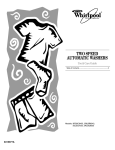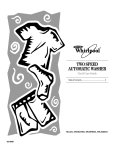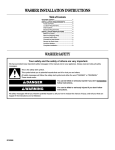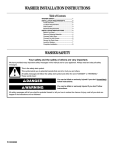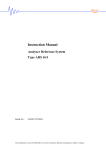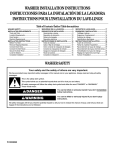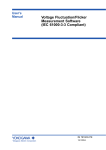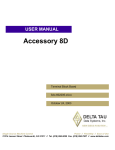Download Whirlpool 3RLBR8543 Use & care guide
Transcript
Completing installation CHECK ELECTRICAL REQUIREMENTS. BE SURE YOU HAVE CORRECT ELECTRICAL SUPPLY AND RECOMMENDED EARTHING METHOD. Check that all parts are now installed. If there is an extra part, go back through steps to see which step was skipped. Turn on water faucets and check for leaks. Tighten couplings if there is leaking. DO NOT OVERTIGHTEN; this could cause damage to couplings. Check that you have all of your tools. Check that the shipping strap was removed from the back of the washer and used to secure the drain hose. Untape and plug power supply cord into earthed outlet. Read the Use and Care Guide. Start the washer and allow it to complete the regular cycle. Congratulations! You have successfully installed your new Whirlpool washer. To get the most efficient use from your new washer, read your Use and Care Guide. Keep Installation Instructions and Use and Care Guide. Need assistance? Call your dealer or local authorized service company. When you call, you will need the washer model number and serial number. Both numbers are on the model/serial rating plate located under the washer lid and on the top of the washer. Part No. 8318424 Rev. A ©2000 Whirlpool Corporation Benton Harbor, Michigan 49022 Printed in U.S.A. Installation Instructions 230-volt, 50-Hz Washer for models 3RLBR8543 3RLSQ8000 3RGSC9455 3SLSQ7533 3RLSQ8533 IMPORTANT: Read and save these instructions. Part No. 8318424 Rev. A Installer: Leave Installation Instructions with the homeowner Homeowner: Keep Installation Instructions for future reference. Save Installation Instructions for local electrical inspector’s use. Before you start Parts supplied for installation Your safety and the safety of others are very important. We have provided many important safety messages in this manual and on your appliance. Always read and obey all safety messages. This is the safety alert symbol. This symbol alerts you to potential hazards that can kill or hurt you and others. All safety messages will follow the safety alert symbol and either the word “DANGER” or “WARNING”. These words mean: Tools needed for installation D C D A F G A E H DANGER You can be killed or seriously injured if you don’t immediately follow instructions. WARNING You can be killed or seriously injured if you don’t follow instructions. All safety messages will tell you what the potential hazard is, tell you how to reduce the chance of injury, and tell you what can happen if the instructions are not followed. Introduction Important: Observe all governing codes and ordinances. Check location where washer will be installed. Make sure you have everything necessary for correct installation. Proper installation is your responsibility. Water heater: Set to deliver 60°C (140°F) water to washer. Earthed electrical outlet (A) is required within 152 cm (5 feet) of upper left corner of washer cabinet. See “Electrical requirements”, Panel B. The installer is to confirm, through the local power supply authority, if necessary, that the machine is connected to a power supply with a maximum impedance of 0.068 + j0.043 ohms for phases (RA + jXA) and 0.0455 + j0.02844 ohms for neutral (RN + jXN). Hot and cold water faucets (B): Must be within 122 cm (4 feet) of the upper right corner of the washer cabinet and provide water pressure 34.5-689.6 kPa (5-100 psi). B A. level B. wrench C. utility knife D. pliers E. scissors B I E C Remove parts from packages. Check that all parts were included. A. 1 drain hose B. 2 inlet hoses C. 1 yellow clamp D. 2 drain hose clamps E. 2 front leveling legs with nuts F. 6 flat water hose washers G. 1 hose extension H. literature package I. faucet adapters Location of washer Support (D): Floor must be sturdy enough to support washer weight (with water) of 143 kilograms (315 pounds). The minimum and maximum motor rotation per minute (R.P.M.) is 950-1425 R.P.M. The minimum and maximum basket R.P.M. is 423-640 R.P.M. Allow 2.5 cm (1 inch) of space between washer and dryer. Do Not store or operate washer below 0°C (32°F) (some water may remain in washer). See Use & Care Guide for “Winterizing” information. The hot and cold water inlets on the back of the washer have 3/4 — 11-1/2 American hose coupling standard threads. Level floor (C): Maximum slope under entire washer — 2.5 cm (1 inch). Installing washer on carpeting is not recommended. A B D C Recessed area/closet installation The installation dimensions shown are the minimum spaces allowable. Additional spacing should be considered for ease of installation and servicing. Additional clearances for wall, door and floor moldings may be required. Allow 2.5 cm (1 inch) of space between washer and dryer. If closet door is installed, the minimum air openings in top and bottom of door are required. Louvered doors with air openings in top and bottom are acceptable. Companion appliance spacing should be considered. Front view Front view (door not shown) Side view closet door closet door 7,6 cm (3") 35,6 cm máx. (14" max.) 310 cm2 (48 inches2) 310 cm2 (48 inches2) 43,2 cm (17") 155 cm2 (24 inches2) 7,6 cm (3") Panel A 10,2 cm mín. (4" min.) 155 cm2 (24 inches2) 0 cm (0") 0 cm (0") 2,5 cm mín. (1" min.) Drain system Untape and open washer lid. Remove packages and hoses from washer. Follow directions for your type of drain system. If a longer drain hose is needed, use drain hose extension kit (Part No. 285702). If drain hose must be shortened, use drain hose kit (Part No. 285442). Laundry tub drain system: Needs a 76-liter (20-gallon) laundry tub. Top of tub must be at least 86 cm (34 inches) high and no higher than 183 cm (72 inches) from bottom of washer (A). A All kits are available from authorized parts distributors. Select the drain hose installation method you need. If your home has: 99 cm (39") to 183 cm (72’’) high, 5,1 cm (2") dia. standpipe 2,5 cm (1") standpipe floor drain overhead sewer standard 76 liters (20 gal.), 86 cm (34") high drain tub or utility sink water not close by Floor drain system: B Requires a siphon break, Part No. 285320 (B). Siphon break must be above high-water level in washer, at least 71 cm (28 inches) from bottom of washer. Additional drain hose will be needed. You will need to buy: nothing 5,1 cm (2") dia. to 2,5 cm (1") dia. standpipe adapter, Part No. 3363920 siphon break, Part No. 285320; additional drain hose, Part No. 3357090; and Connector Kit, Part No. 285442 standard 76 liters (20 gal.), 86 cm (34") high drain tub or utility sink and sump pump (available from local plumbing suppliers) nothing Standpipe drain system: Needs a 5-cm (2-inch) minimum diameter standpipe with minimum carry-away capacity of 64 liters (17 gallons) per minute. A 5-cm (2-inch) diameter to 2.5-cm (1-inch) diameter standpipe adapter, Part No. 3363920 must be used with 2.5-cm (1-inch) diameter drain system. Floor standpipe drain: Top of standpipe (C) must be at least 99 cm (39 inches) high and no higher than 183 cm (72 inches) from bottom of washer. C Wall standpipe drain: Top of standpipe (D) must be at least 99 cm (39 inches) high and no higher than 183 cm (72 inches) from bottom of washer. 2 longer water inlet hoses: 1,8 m (6 ft.) hoses, Part No. 76313 or 3 m (10 ft.) hoses, Part No. 350008 Requirements WARNING Electrical Do Not earth to a gas pipe. Recommended earthing method Check with a qualified electrician if you are not sure that washer is properly earthed. For your personal safety, this washer must be earthed. This washer is equipped with a power supply cord having an earthing plug. To minimize possible shock hazard, the power supply cord must be plugged into a mating earthing-type wall receptacle earthed in accordance with local codes and ordinances. If a mating wall receptacle is not available, it is the personal responsibility and obligation of the customer to have the proper earthed wall receptacle installed by a qualified electrician. Do Not have a fuse in the neutral or earthing circuit. In the U.S. only: If codes permit and a separate earthing wire is used, it is recommended that a qualified electrician determine that the earthing path is adequate. Electrical Shock Hazard Plug into an earthed outlet. Do not remove ground prong. Do not use an adapter. Do not use an extension cord. Failure to do so can result in death, fire, or electrical shock. Installation Steps If the supply cord of this appliance is damaged, it must be replaced only by a repair shop appointed by the manufacturer, because special tools are required. A 230-volt, 50-Hz, 10-amp, fused electrical supply is required. Timedelay fuse or circuit breaker is recommended. It is recommended that a separate circuit serving only this appliance be provided. Preparation B A D E C WARNING Excessive Weight Hazard Use two or more people to move and install washer. Failure to do so can result in back or other injury. D SLIDE WASHER ONTO CARDBOARD OR HARDBOARD BEFORE MOVING ACROSS FLOOR. Pull firmly to remove the other end of the shipping strap (D) from the back of the washer to release self-leveling legs (E). Move washer close to its final location. Read, then remove the label (A) that covers the power supply cord and drain connector. Peel the tape down and off each side of the cabinet. Remove shipping strap (B). Completely remove the shipping strap with 2 cotter pins (C) from the inside of the washer. Pull the strap completely out of the washer. Save the shipping strap to secure drain hose. Inlet hose connection (to washer) Use new hoses, washers, and adapters that came with your washer. Check inlet hoses periodically. Replace inlet hoses if you find bulges, kinks, cuts, wear or leaking. Replace inlet hoses after five years of use. Panel B B C A E D Insert one large flat washer (A) into each end of the inlet hoses (B). Check that washers are firmly seated in couplings (C). Attach hose (without adapter) to hot water (bottom) inlet valve (D) first; then second hose (without adapter) to cold water (top) inlet valve (E). Tighten couplings by hand. Then use pliers to make additional twothirds turn. DO NOT OVERTIGHTEN; this could cause damage to couplings. Inlets are plastic. DO NOT STRIP OR CROSSTHREAD. Drain hose connection If drain hose does not fit into standpipe or is being placed over the edge of a laundry tub, open other drain hose clamp with pliers and place clamp over rubber end of drain hose (G). F IMPORTANT: THIS PROCEDURE MUST BE FOLLOWED TO ASSURE PROPER INSTALLATION. G E AM P CL C Standpipe or laundry tub drain system: Open yellow clamp (E) and slide over “hook” end of drain hose (F) to secure the rubber and corrugated sections together. A B Floor drain system: Do Not install “hook” end of drain hose to corrugated section. Consult your plumber for proper installation. 1/4" (.64 cm) Insert end of hose extension (H) into rubber end of drain hose up to stops on the sides of hose extension. Secure with clamp. H D Put “hook” end of drain hose into laundry tub or standpipe. Check for proper length of drain hose. To prevent drain water from going back into washer: • Do Not straighten “hook” end of drain and force excess drain hose into standpipe. • Do Not lay excess drain hose in bottom of laundry tub. Run water through both faucets into a bucket to get rid of particles in the water lines that might clog hoses. Mark the hot water faucet. To prevent the drain hose from coming off or leaking, it must be installed per the following instructions. • Wet the inside end of the drain hose (A) with tap water. DO NOT USE ANY OTHER LUBRICANT. • Squeeze ears of one drain hose clamp (B) with pliers to open and place clamp over the end of the drain hose. • Open clamp and push end of drain hose onto drain connector (C) until hose contacts ribbed stop (D). • Place clamp over area marked “clamp”. Release clamp. Inlet hose connection (to faucets) B A C D F E • For both inlet hoses: Insert one large flat washer (A) into end of coupling (B); then attach faucet adapter (C). Insert one small washer (D) into end of faucet adapter. • Make sure washers are firmly seated into couplings. Attach bottom hose with adapter from the inlet marked “H” to hot water faucet (E). Attach top hose with adapter from the inlet marked “C” to cold water faucet (F). Tighten couplings to faucets by hand; then use pliers to make final two-thirds turn. DO NOT OVERTIGHTEN; this could cause damage to couplings. Leveling washer B 1.3 cm (1/2") C Screw nut (B) down on legs to within 1.3 cm (1/2 inch) of base (C). D Insert legs into correct holes at each front corner of washer until nuts touch washer (D). DO NOT tighten nuts until washer is level. Tilt washer forward, raising back legs 2.5 cm (1 inch) off of floor to adjust rear self-leveling legs. Drop washer to floor. Check levelness of the washer by placing a carpenter's level on top of the washer, first side to side; then front to back. Tilt washer backward and remove corner posts. Gently lower washer to floor. A Stack two corner posts (A) on top of each other. Tilt washer backwards and slide corner posts under washer 7.6 cm (3 inches) from each side of washer as shown. If washer is not level, adjust the front legs (E) up or down. Repeat above step. When washer is level, use wrench to turn nuts on front legs up tightly against washer base. If nuts are not tight against washer base, the washer may vibrate. E Move washer to its final location. Remove cardboard or hardboard from under washer. Securing drain hose A E B C about 41 cm (16") B D D Note: Use shipping strap to secure drain hose. Water pressure could cause drain hose to come out of standpipe or laundry tub if drain hose is not secured. Check that hose is not twisted or kinked and is securely in place. After shipping strap has been removed from washer, look for the words “cut here” marked on the shipping strap, about 41 cm (16 inches) from the plug end. Cut the shipping strap at this mark (A). Put “hook” end of drain hose in laundry tub (B) or standpipe (C). Tightly wrap the shipping strap (D) around the drain hose and laundry tub or standpipe. Push plug into the nearest hole in the shipping strap. Panel C If the water inlet faucets and drain standpipe are recessed, put “hook” end of drain hose (E) in standpipe. Tightly wrap the shipping strap (F) around the drain hose and faucet body (not the handle or stem). Push plug into the nearest hole in the shipping strap. F If a longer drain hose is needed, drain hose extension kit (Part No. 285702) is available from authorized parts distributors. If drain hose must be shortened, use hose kit (Part No. 285442). Note: If washer is moved to adjust drain hose, the washer must be leveled again. Repeat leveling steps, see "Leveling washer", Panel C. Place cardboard under the washer and carefully move washer to avoid damaging floor covering. C H Completing installation CHECK ELECTRICAL REQUIREMENTS. BE SURE YOU HAVE CORRECT ELECTRICAL SUPPLY AND RECOMMENDED EARTHING METHOD. Check that all parts are now installed. If there is an extra part, go back through steps to see which step was skipped. Turn on water faucets and check for leaks. Tighten couplings if there is leaking. DO NOT OVERTIGHTEN; this could cause damage to couplings. Check that you have all of your tools. Check that the shipping strap was removed from the back of the washer and used to secure the drain hose. Untape and plug power supply cord into earthed outlet. Read the Use and Care Guide. Start the washer and allow it to complete the regular cycle. Congratulations! You have successfully installed your new Whirlpool washer. To get the most efficient use from your new washer, read your Use and Care Guide. Keep Installation Instructions and Use and Care Guide. Need assistance? Call your dealer or local authorized service company. When you call, you will need the washer model number and serial number. Both numbers are on the model/serial rating plate located under the washer lid and on the top of the washer. Part No. 8318424 Rev. A ©2000 Whirlpool Corporation Benton Harbor, Michigan 49022 Printed in U.S.A. Installation Instructions 230-volt, 50-Hz Washer for models 3RLBR8543 3RLSQ8000 3RGSC9455 3SLSQ7533 3RLSQ8533 IMPORTANT: Read and save these instructions. Part No. 8318424 Rev. A Installer: Leave Installation Instructions with the homeowner Homeowner: Keep Installation Instructions for future reference. Save Installation Instructions for local electrical inspector’s use.





